Functioning Levels
Kris Roose:
The Functioning Levels Model gives a general description of the modes an intelligent system functions, as well individuals (humans, higher mammals) as groups (societies, cultures, companies). This model explains some hitherto more isolated models, including Freud's developmental stages of personality and society, stages of bereavement, psychiatric illnesses, and some recent models, including P2P, Spiral Dynamics and the Temenos Model.
Introduction
This model was developed in the early 1980s at the [Academy for Integrative Psychology], aiming at training people towards higher levels of psychological and interactive functioning. It is based itself on the Integration Model [1,2], which describes how, rather than by making painful choices and artificial compromises, apparently conflicting statements and tendencies can be constructively reformulated into integrative combinations of all contributed elements.
The Fundamental Existential Conflict
The fundamental conflict, experienced by every intelligent system (individuals and groups), striving towards the realization of an internal agenda (needs, desires, program), is the fact that the space, the environment in which one lives/acts/operates is not necessarily, and most often not at all, congruous with the naive intentions of the active system. Changes have to be performed, before a congruency between the acitivities the intelligent system and the opportunities of the environment can be realized. Those changes have to occur within the active intelligent system, and/or within the related environment. Those two factors of the fundamental conflict can be symbolized by two vectors: I and A.

The I-vector is the collection of all needs, desires, agendas, programs, intentions, as well the conscious as the inconscious, of the active, intelligent system.
The A-vector is the collection of all opportunities, limitations, expectations and aggressive activities of the environment. This "environment" includes everything, from our own body and tired mind to fortuitous and intentionally constructed material and organizational structures.
The angle between both vectors is symbolic. It has to be somewhere between 0 and 180 degress. It is more than 0 degrees, because 0 degrees should suggest an automatic compatibility between the two vectrors, which evidently is not the case. It should be less than 180 degrees because, in most cases, we are able to realize, at least in part, our projects (I) within the actual situation (A) . So let's take something around 90 degrees.
Both vectors delineate a realization field that represents every possible action. Each action, behaviour, attitude, can be represented by a point, that indicates in which measure each of both fundamental vectors are realized within this particular action. Points in the right half of this field indicate that priority is given to the one's own needs, probably at the detriment, or by not-using the opportunities, of the external environment. Points at the left side indicate that external factors more contributed to the realization of this behaviour/action than internal needs. If the point is higher, it suggests that a higher integration between both fundamental factors is realized. The ideal, of course, is as high and as central as possible. This indicates a maximal realization of self, maximally using the available resources and opportunities and with the least possible conflict.
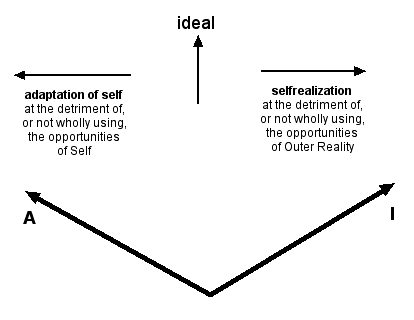
Functioning levels
If one takes into account the [[[Integration | three fundamental ways]]] by which conflicts/divergencies/incongruencies can be solved --i.e. selection, compromise or partial integration, and integration--, the "realization field" can be divided into 5 or more typical fields. If one performs subdivisions, more subfields are discernable. Let's limit us to 5 for the time being
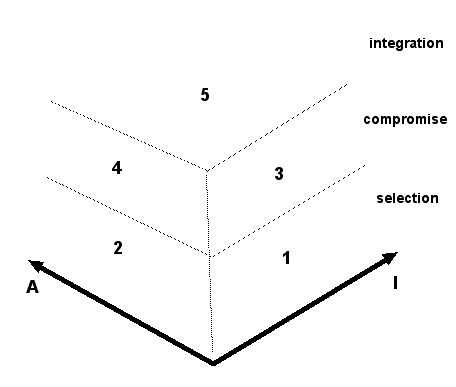
Those five fundamental fields roughly can be described as:
a. using the selection paradigm
- 1. non-adaptation: a self-realization is attempted without taking reality into account. Of course, this is only possible in fiction, delusion, phantasms or imagination, or in extreme isolation in artifical conditions.
- 2. over-adaptation: the subject is totally adapted to the exigencies of real environment. Incompatible needs are not or nearly not realized.
b. using the compromise (or partial integration) paradigm
- 3. anti-adaptation: there is a partial selfrealization, but greatly in opposition with the environment.
- 4. superior adaptation: the rules and exigencies of reality are respected to so a certain extent, and within these limitations a maximal self-realization is performed.
c. using the integration paradigm
- 5. self-realization: there is a high degree of realization of the subject's needs, in compliance with or even using the opportunities present in the real situation.
Analogous models with more subdivised fields are possible, as we will see below.
The surprising consequence in (obligatorily) transiting through these stages (from 1to 5, and not for instance 2-1-4-3-5, or random leaps within this order) will be discussed elsewhere. This typical progression, that suggests a reactive progress (oscillating between opposites) and somehow seem to occur along a cycle or a kind of spiral, will be studied elsewhere.
Some Applications
Freud's developmental model
Freud's model
Freud's "psychosexual stages of development" (some explanation) include 6 stages: oral, anal, phallic, latency, puberty, genital. Many people mix up phallic and genital because, linguistically speaking, it is more or less the same word, and Freud didn't extend too much on genital, because he was more interested in the neurotic stages (oral, anal and phallic) and, moreover, one particular neurotic behaviour of the phallic stage is labeled with the word genital (the s.c. genital-hysterical neurosis).
This linear model describes the transition -iin obligatorily consecutive stages-- from early states of deveopment towards adolescence.
Oral is described as a state of submission to external gratifiers, uncontrolled and sometimes exagerated uttering of spontaneous feelings and emotions, with excessive attitudes including hysteria, masochism, trance.
Anal is described as a state of strong control of the environment, but also of self, including (paranoid) sensitivity to negative intentions of others, the use of strong and often painfull means of control, going to sadism, obsessions, compulsions.
Phallic (or narcissistic) is described as a state of proudness, often self-satisfied and arrogant.
All these stages, which are labeled as "neurotic", have their anxiety sides if the neurotic objectives can't be realized.
After these early stages, Freud described a latency period, "during which sexual feelings are suppressed to allow children to focus their energy on other aspects of life. This is a time of learning, adjusting to the social environment outside of home, absorbing the culture, forming beliefs and values". In fact, as we will see, in each new environment the developmental stages restart: school, peers, persons of the opposite sex.
After this latency period we have a puberty, which strongly reminds an anal phase, and progressively the genital phase is attained, during which harmonious relationships develop.
Later on, Freud added a fusional or symbiotic stage to the list, preceding the oral stage. During this stage, the child is unable to cope with reality, confuses self and the caring environment, as a fetus did in the maternal woomb.
An integrative approach
The Functioning Level Model can easily explain Freud's model, explains this mysterious choice of sexual labels, and in fact resolves some inconsistencies of Freud's model, including the mysterious latency period, the unexpected anal-like puberty, and analogies and easy regressions between non-consecutive stages: the genital-hysterical and oral stages at one hand, and the anal and fusional stages at the other hand.
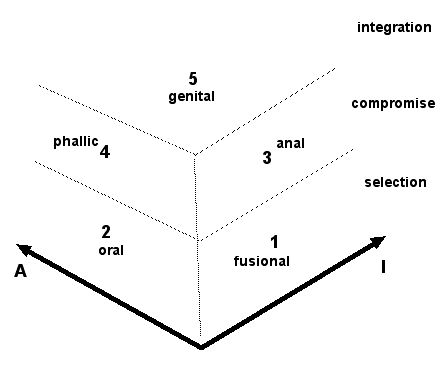
1. fusional: during this stage, reality is not perceived as such, and the subjective existence is totally fictive, phantasmatic. Freud's "reality testing dimension" is at its lowest height.
2. oral: this is, in fact, a strong submission of the subject to the influences and sometimes to the incursions of the environment. Of course, some internal needs are satisfied, thanks to the caring parent, but the way this is done is completely decided by the environment.
3. anal: during this stage the subject transits a period of opposition, i.e. an oppositional attempt of self-realization. In the early anal stage this is illustrated by conflicts about stools, at a later age (puberty) this occurs predominantly with authority figures, e.g. the father.
4. phallic: the subject, leaving the frustrating and often unfruitful opposition stage, starts excelling within the rules of society, and succesfully tries to realize the internal needs by pre-eminence and supremacy.
5. genital: the subject succeeds (more or less) in an harmonious integration between the internal needs and the needs of others, using available opportunities.
During this integration, some other aspects are clarified:
1) These stages are not unique moments, linked to early age, but are to be interpreted as general functional stages applicable each time that a new interaction field is encountyered by an intelligent system or being. in life. Some typical consecutive interaction fields are: the early child environment (0-5 years), the school with the first encounter of peers, Living as a more or less independent adult, including the beginning of an independent dual relationship, social life, professional life, etc. In each of these newly dicovered environments, the developmental stages restart, explaining puberty --as an opposition against the too dependent child status--, students' revolts --as an opposition against the too manipulative and deceitful society, the crisis in marriage after 5-7 years (often an opposition of the weakest partner), etc.
2) Freud's psychotrauma hypothesis, inspired by the "analogy" of "psychosexual" child developmental problems and adult problems. Freud interpreted this as a proof that some typical neurotic problem was not resolved during infancy, and became manifest in adult life, hence the need for psychoanalysis to go back to these early experiences. Other psychological theorists refuted this vision. In the here presented model, the analogy between adult problems and early childhood experiences and "unresolved" developmental traumas is not longer interpreted as a proof for such a linkage, but as an analogy because those processes occur more than once in life.
The relational development
The psychoanalytical model
Related to Freud's early developmental stages, there are some typical social developmental stages a child and adolescent pass through. Although each psychological school has its own terminology, explanations and age limits, roughly the next stages seem generally accepted:
1. The reflex stage: there seems not to be an intended action. The child just reacts, more or less as an animal, to triggers as hunger and pain. Most often, activated by this signal, the caring parent starts to satisfy the child's need.
2. The conscious mimicry of the reflex: during the previous stage, the subject gradually discovers that satisfaction is elicited by attracting the attention of the caring parent. By conditioning --or is it a need in itself?-- the attention becomes a need in itself, and progressively a host of activities are deployed to attract attention, from crying and smiling to making noise and other activities. When crying from hunger, the child already stops crying when he/she observes that the caring parent approaches, and seems already satisfied with this attention, even long before he/she is actually fed.
At this point most often a terrible experience occurs: the discovery of the competitor. This competitor can be another child, younger of older, the other parent, or even domestic animals. It does not longer suffice to attract attention: the most attention is to be gained, more than the competitors. We define appreciation, one of the most fundamental needs, as the experience that one seems to have more value than one's competitor. The two next stages are attempts to surpass the competitor:
3. Aggressing the competitor. Sustained by its inborn aggressive reflexes, the young child starts to prove that the competitor is less important than self. By teasing, inflicting pain, insulting, ridiculizing, chasing away, the subject, feeling threatened, tries to demonstrate its superiority over the competitor. In fact, during this stage, the aim is to prove that I>A by lowering A (the competitor). This aggression, generally directed towards the partner of the caring mother, inspired Freud to the use of the Oedipal myth.
4. Exhibiting one's qualities. Although the aggressiveness is successful to a certain degree, it can't be continued because it yields two important complications: the aggressed competitor strikes back, and society in general and the caring parent in particular strongly disapprove aggressiveness. Another, socially more acceptable strategy is then developped: vaunting, displaying one's own qualities, and suggesting that these are more valuable than the competitor's qualities. The aim is still to prove that I>A, but now by elevating I (self).
The long quest for attention and appreciation arrives now at a point that the subject becomes conscious that aggression and vaunting not really induce appreciation, even if people seem to feel a certain fear or respect. In fact, the subject becomes conscious of the Second Fundamental Existential Conflict: nobody is spontaneously motivated to fulfill our most important need: appreciation, simply because everybody has the same strong need, and appreciation always implies an exclusive comparison of the qualities of both. By trial and error (and surely, some instincts do help), everybody discovers, sooner or later, the reciprocality strategy: "I'll give you appreciation --your greatest need-- on condition you give me the appreciation I need." This is, most often, a silent agreement, not only because overt discussion of this point should make appreciation a little bit unreliable if not hypocritical (as in flattery), but there is also a social taboo, because this reasoning is conflicting with the myth of altruistic love. Moreover it is possible to honestly disagree in this quality comparison: both partners can be convinced of the superiority of the other over self, but nevertheless they still need each other's appreciation. It is interesting to pobserve, at this point, that nature was much helpful to resolve this paradox, by creating two genders: generally speaking, a man has no problem to consider his wife as the most exquisite of all women, and vice versa. Once the risky boundary of the silent reciprocicality agreement is passed, two new interactive strategies become possible:
5. Stressing the other's qualities, i.e. explicitly expressing one's honest admiration and appreciation for the other (unconsciously expecting reciprocicality).
6. Humility and servability. One is more preoccupied by the needs of the other than with one's own needs, showing much appreciation for the other by humiliating oneself. Of course, again, one unconsciously hopes for reciprocicality, although this will often be denied.
The integrative approach
These six modes of social interaction are easily reducible to the Functioning Levels Model, as well as to the Freudian model:
Oral: interactive stages 1 (reflex) and 2 (reflex mimicry): just showing one's needs and feelings
Anal: stage 3 (the aggressive approach)
Phallic: stage 4 (vaunting)
Genital: stages 5 and 6: the exchange of appreciation to simultaneously fulfilling each other's needs.
The Health/Pathology model
Freud's vision
In the beginning of the history of psychiatry a number of psychiatric pathologies were discerned. But no systematic classification, apart from a rough splitting up into neuroses and psychoses, was available. Freud started with linking some typical pathologies to developmental disturbances: hysteria was oral, obessive behaviour was anal.
The integrative vision
But other pathologies can be linked to the stages of the Functioning Levels Model as well. We first extend the model with a new border: at the extremes of one-sided realization, at both sides, pathologies arise, i.e. functional modes with a high intensity of non-integration.
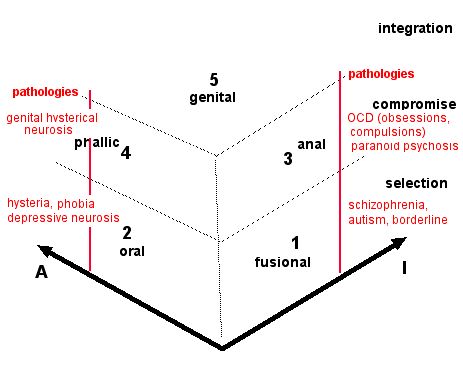
At the right side we encounter the un-realistic pathologies: the psychoses. The 1-psychosis is developing rather early (autism during youth, schizophrenia from age 20 on), because no real integration with reality occurred. The 3-psychosis, paranoid psychosis, is much more "realistic", because the patient lived more or less "normally" during 30-40 years.
At the left side we encounter hyper-realistic pathologies, where the patient intensiveley interacts with reality but nevertheless feels bad. Such a model is not only an intellectual game. It makes pathologies more understandable, and gives us good suggestions for therapy: as pathologies can be considered as forms of extreme non-integration, a successful psychothery will (re)develop the skill of integration, and its underlying conditions. We will extend on this point in other articles.
The Stages of Bereavement
The Traditional Vision
Some decades ago bereavement got no special attention. It was considered as a rather simple natural process of forgetting one's sadness, and --in severe cases-- as a kind of depression. But as psychotherapy and all kinds of social assistance advanced, it became gradually more important: assistance to victims of sexual aggression and hostages, to increasing numbers of cancer patients, even children, and their parents, assistance to dying people, and generally speaking gradually more attention for the victims than for the criminals, made that a deeper analysis of the bereavement process and its treatment arose.
Several authors (Google) discribed in detail the stages of grief and bereavement: denial, anger and resentment, bargaining, depression, and acceptance. Others sum up disbelief, shock, numbness and feelings of unreality; anger; feelings of guilt; sadness and tearfulness; seeing or hearing the voice of the deceased; beginning to accept the loss and readjust.
An Integrative Approach
It is possible to describe very easily the different stages of the bereavement process, using the Functioning Model.
1. Denial. This is the first reaction: disbelief, and having sometimes the illusion that the loss isn't real: one imagines to hear or see the lost person, one expects that the door will just open and he/she will be back again, one supposes that just going back to the lost lover and take him/her into one's arms will repair the rupture, etc. This clearly is stage 1 of the Functioning Model: no contact with reality.
2. Sadness and depression. One realizes, often with a shock, that the loss is irreversible, and feels sad, powerless and helpless. No consolation helps. One doesn't belief that the loss ever will be repaired or compensated. This is stage 2: an oral kind of pessimistic realism, not seeing any issue, and undergoing it without opposing.
3. Anger. This rather surprising stage of bereavement was only described from the seventies on. It is not only anger against Fate or the person, guilty of the loss (including onself), but also against the person one has lost. This stage is conflicting with a social taboo, prohibiting us to be angry on innocent people or people who loved us. This also makes that spontaneous bereavement is often blocked at this stage, and professional help is indicated. But it is clearly stage 3 of the Functioning Model.
4. Superiority. The anger evolves towards a kind of disdain towards the cause of the grief, the lost lover, the approaching death, etc. One realizes that it/he/she is not worth being sad for it, and can really detach oneself from the pain of the souvenir/the prospect. Sometimes (e.g. after finding a more attractive new job or partner) one is even glad that the loss occurred, after all. It helped to make progress. This is stage 4 of the integrated model: one feels superior with reality as it is.
5. Neutrality. The bereavement process --if succesfully experienced through all its stages-- concludes in a kind of renewed neutral attitude, sometimes called "acceptance", allowing to continue life without problems, and even --if applicable-- to meet and to cooperate with the lost lover as if no problems ever occurred, sometimes even with a certain understanding and gratefulness for the common experience. This is clearly an integration of the own needs with the new reality.
Bereavement is a complicated process, because few people go through all stages. Repression of the loss, blocking the process at an early stage, is very common, and leaves often, of course, an unconscious vulnerability for experiences that could trigger these repressed memories.
This striking analogy between bereavement and Freud's developmental stages proves, once more, that those stages are not typical for the emotional development of the individual, but rather a more fundamental phenomenon.
The Stages of Social Development
The Traditional Vision
The analogy between the history of an individual, on the one hand, and the history of racially determined civilizations, on the other, appears as a common trope in 19th century Romantic anthropology. To put it plainly, children begin as little savages and become more civilized as they grow up. A clear measure of this progress, according to authors as Elias, Steffens, Carus and Klemm (more) can be seen in manners. Just as children learn to be polite, say, at the table, so, too, society has abandoned its more Rabelaisian habits.
Altough the observed analogies proved rather simple and Darwinian, and dangerous associations were made with racism, the idea was launched. But, as with Freud, we are suggesting that, if society is passing through analogous stages as individuals do, it is not because societies as composed of humans, but because both are conscious systems in development.
Here the Integrative Functioning Model is presented. The integration with other current models will be treated in separate articles.
The "Methodos" Model: Chaos, Ethos and Eros
The major stages. Each group or society passes through three major stages: Chaos, Ethos and Eros, also called the Primary, Secondary and Tertiary stages.

1. Chaos: in this stage there is no order or organization. The "laws" of the most powerful and of the first apply, and there is, as in animal societies, no consideration for the effects upon others, and even not for the effects on the long run upon self. This stage is analogous to the over-adaptation (no-resistance) stage of the Integrative model, or Freud's oral stage, at least form the standpoint of the subjects which undergo the actions of the others. It is the selection funtioning level, because subjects have only the choice to accept the superiority of stronger or quicker subjects.
2. Ethos: in this stage, some "more clever" or "less scrupulous" people start organizing, at an ever increasing scale, the behaviour and lives of other people, imposing some things, forbidding other. The unstructured group dissociates into a minority of rulers, and a majority of subalterns, the multitude (to use a term from Negri). Ethos (fr. Greek) means: custom, law. I comprehend in this word all the factors that regulate the multitude: hierarchies, governmental systems, laws, and, not to forget, myths and taboos, that regulate the group's thinking about the imposed regulation, enhancing the moral pressure and avoiding a too quick discovery of hidden agendas. This stage can be interpreted as the compromise (or partial integration) level of the model, as it uses as well anal as phallic methods, as we will describe below. It is the compromise stage of conflict solving, because the actual situations are always the result of a struggle between the rulers and the multitude.
3. Eros: in the most evolved stage, regulation is no longer imposed by external forces, but spontaneously emerges from the consciousness, the motivation, the selfdiscipline and the very effective communication of group members. There are no more hierarchies, but a peer to peer organization. Myths and taboos are replaced by an open discussion of the real aspects of the system. This stage, of course, coincides with the integrative level of the Functioning Model, Freud's genital phase. A more extensive discussion of tertiary functioning is presented in another article.
It is important to see, as suggested by the graphic, that the evolution doesn't occur at the same speed in the different aspects of cooperation and interaction. It starts with the most obvious, material, physical aspects: respect for life and property, physical and sexual integrity, elementary human rights, etc. and progressively evolves towards "higher" levels of social interaction, related to emotional, cultural and spiritual topics.
The secondary subphases. The secondary stage, Ethos, is a very important stage, as it probably occupies most of social evolution, starting quick and lasting long (the graph is rather suggestive and doesn't indicate quantitive aspects).
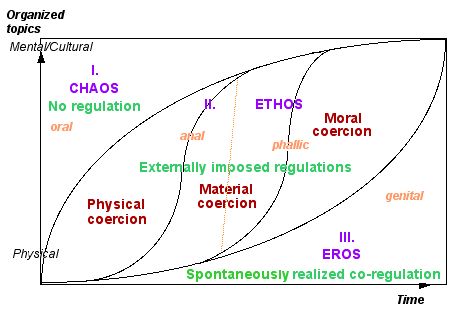
a. Physical Ethos: in this stage, the group or society is regulated by physical coercion: brutality, military force, justice with painful and capital punishment. The Myths sustain the use and the rightfulness of force, the right of taking someone's life, the Divine origin of force, etc. It is the age of Kings and Emperors.
b. Material Ethos: in this stage, brutal physical ruling progressively is replaced by "material" ruling: the force of money, material restrictions or rewards, wages. It is the age of capitalists, bankers and businessmen, largely surpassing the possibilities of Kings and Emperors. It started with the Templars and the Italian Bankers, and continues in nowadays multinational societies, progressively loosed from the control of the political ruler. Laws more and more include restrictions to regulate the power of the Big Business.
c. Moral Ethos: in this stage the imposed regulation more and more uses mental, "moral" tools to organize, limit and stimulate the behaviour of group members. The notion of Minimal Right becomes important, the influence of press, media and pressure groups is essential. As democracy is installed, it becomes important for candidate rulers to preserve their immaterial name and fame, to be eligible and effectively elected.
These three substages --physical, material and mental-- are not so surprising. They describe, in fact, the transition from direct towards indirect coercion methods, and reflect the growing resistance from the multitude against blunt manipulation.
Those three sublevels don't of course, evolve linearly. They vary from local to global, from sectors (from oil to film making), countries, etc. There are also fluctuations, partly due to colonization, migration and cultural interaction. Severe crises may create unexpected shifts in power, enabling regressions as well as spectacular progress in a short period.
Somewhere during the Material Subphase, the organizing paradigm shifts from (3) anal to (4) phallic: precisely at the moment when the prospect of having money, and the use of it as a status symbol becomes more important than its brute function for enlarging one's own possibilities and restricting the possibilities of other people.
At this particular point of history humankind is transiting from the secondary towards the tertiary stage. The P2P movement is perhaps one of the most striking illustrations of this evolution.
The details of this Social Evolutionary Model, as well as a comparison with some other, current, models (including Ray Harris' Temenos Model, Don Beck's Spiral Dynamics model, and Leary's Rose), will be discussed soon.
References
[1] Roose, K, Ontwerp voor een integratieve psychologie, Academie voor Integratieve Psychologie, Gent (B), 1980.
[2] Roose, K. & Van Brandt, B., Het geheim van het geluk, Kluwer, Antwerpen (B), 1985, ISBN 90-6716-442-9